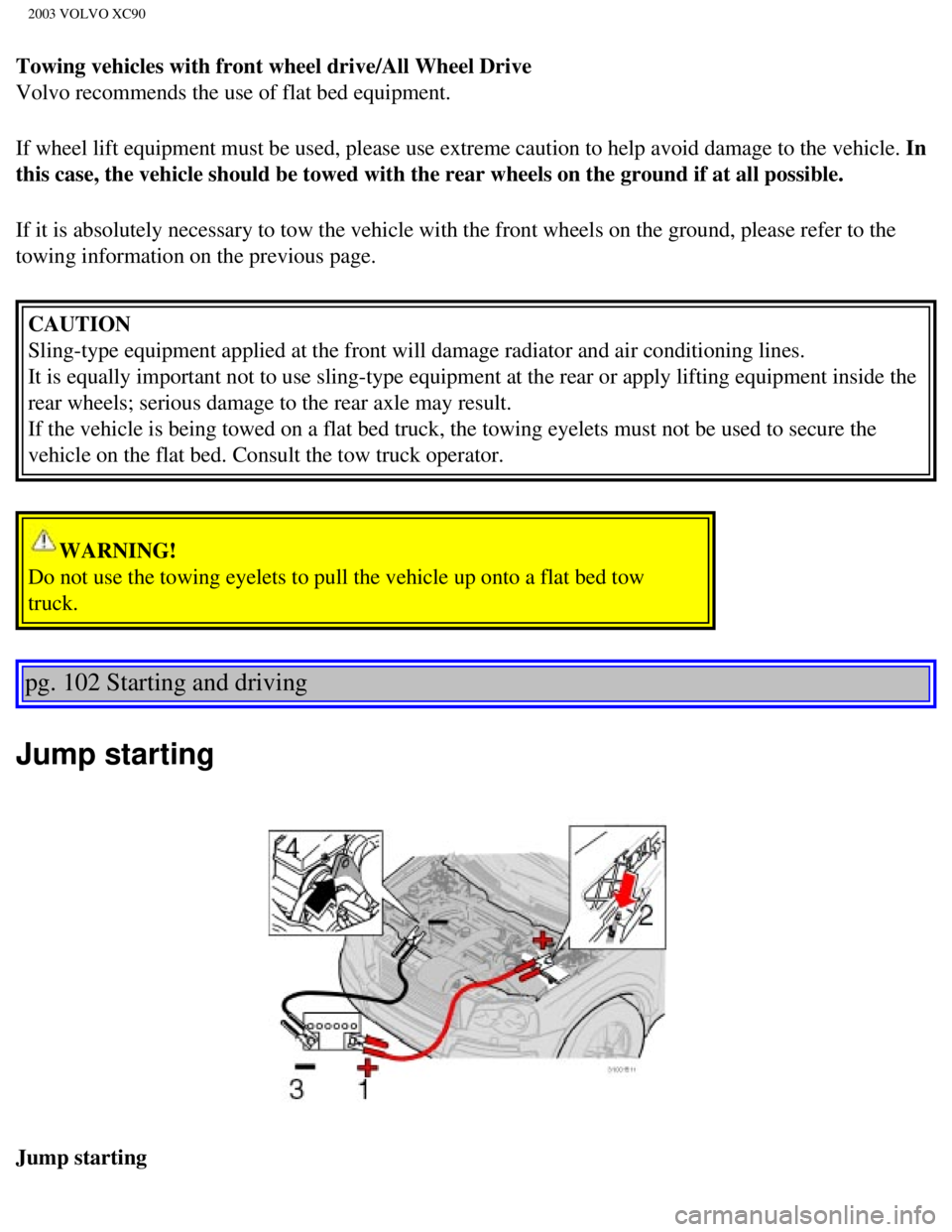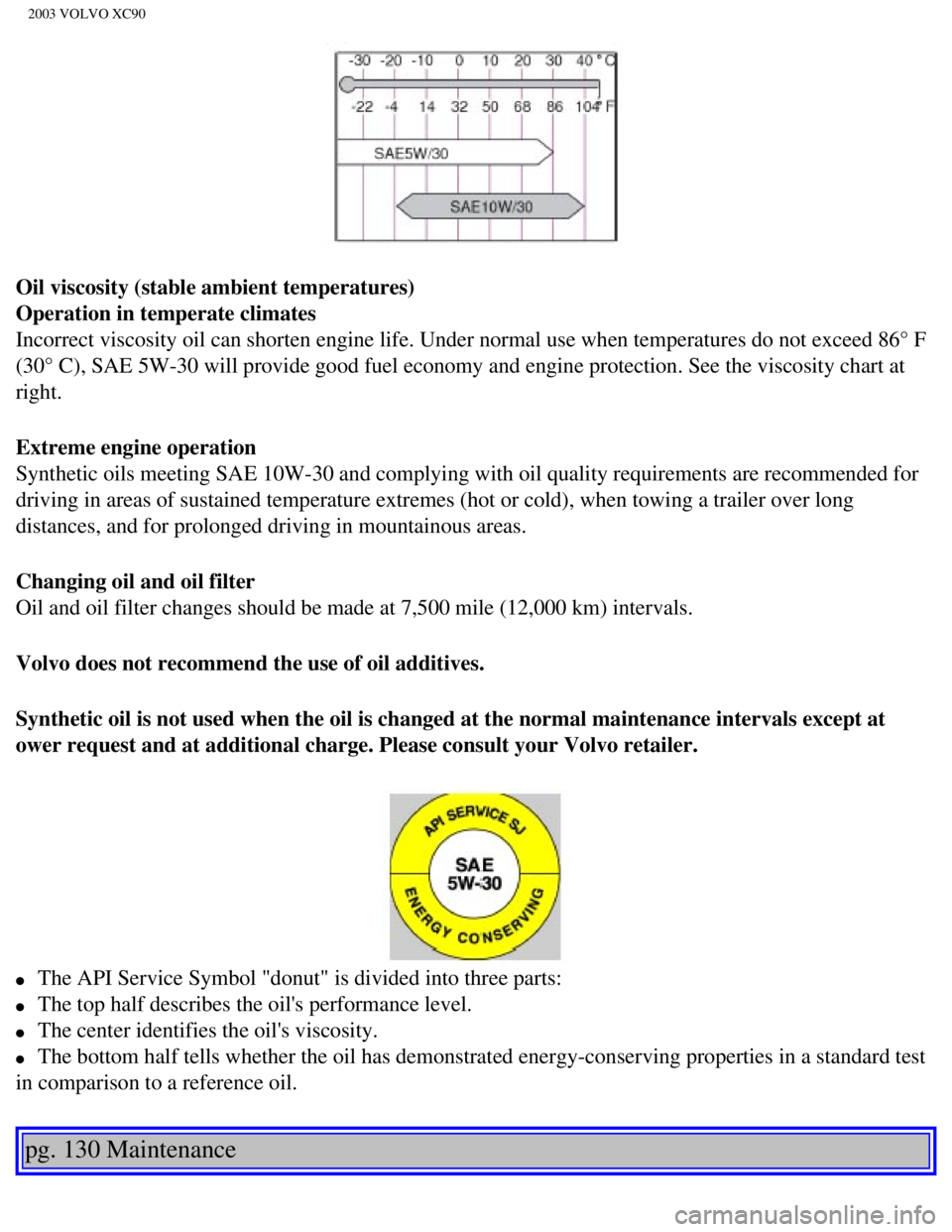Page 127 of 242

2003 VOLVO XC90
Towing vehicles with front wheel drive/All Wheel Drive
Volvo recommends the use of flat bed equipment.
If wheel lift equipment must be used, please use extreme caution to help\
avoid damage to the vehicle. In
this case, the vehicle should be towed with the rear wheels on the groun\
d if at all possible.
If it is absolutely necessary to tow the vehicle with the front wheels o\
n the ground, please refer to the
towing information on the previous page. CAUTION
Sling-type equipment applied at the front will damage radiator and air c\
onditioning lines.
It is equally important not to use sling-type equipment at the rear or a\
pply lifting equipment inside the
rear wheels; serious damage to the rear axle may result.
If the vehicle is being towed on a flat bed truck, the towing eyelets mu\
st not be used to secure the
vehicle on the flat bed. Consult the tow truck operator.
WARNING!
Do not use the towing eyelets to pull the vehicle up onto a flat bed tow\
truck.
pg. 102 Starting and driving
Jump starting
Jump starting
file:///K|/ownersdocs/2003/2003_XC90/03xc90_06b.htm (9 of 17)12/30/200\
6 4:18:59 PM
Page 129 of 242

2003 VOLVO XC90
pg. 103 Starting and driving
Towing a trailer
Volvo recommends the use of Volvo trailer hitches that are specially des\
igned for the vehicle.
l Maximum trailer weights recommended by Volvo are:
All models - trailers without brakes: 1,650 lbs (750 kg)
Models with all wheel drive - trailers with brakes: 4,960 lbs (2250 kg)\
Models with front wheel drive - trailers with brakes: 3,970 lbs (1800 k\
g)
Observe the legal requirements of the state/province in which the vehicl\
es are registered.
l All Volvo models are equipped with energy-absorbing shock-mounted bumper\
s. Trailer hitch
installation should not interfere with the proper operation of this bump\
er system.
Trailer towing does not normally present any particular problems, but ta\
ke into consideration:
l Increase tire pressure to recommended full. See section "Wheels and tire\
s."
l When your vehicle is new, avoid towing heavy trailers during the first 6\
20 miles (1,000 km).
l Recommended hitch tongue load is: Trailer weights below 2,650 lbs (1,200 kg) - 110 lbs (50 kg)
Trailer weights above 2,650 lbs (1,200 kg) - 198 lbs (90 kg)
l Maximum speed when towing a trailer: 50 mph (80 km/h).
l Engine and transmission are subject to increased loads. Therefore, engin\
e coolant temperature should
be closely watched when driving in hot climates or hilly terrain. Use a \
lower gear and turn off the air
conditioner if the temperature gauge needle enters the red range.
l If the automatic transmission begins to overheat, a message will be disp\
layed in the text window.
l Avoid overload and other abusive operation.
l Hauling a trailer affects handling, durability, and economy.
l It is necessary to balance trailer brakes with the towing vehicle brakes\
to provide a safe stop (check
and observe state/local regulations).
l Do not connect the trailer's brake system directly to the vehicle's brak\
e system.
l More frequent vehicle maintenance is required.
l Remove the ball and drawbar assembly when the hitch is not being used.
l Volvo recommends the use of synthetic engine oil when towing a trailer o\
ver long distances or in
mountainous areas.
file:///K|/ownersdocs/2003/2003_XC90/03xc90_06b.htm (11 of 17)12/30/20\
06 4:18:59 PM
Page 130 of 242

2003 VOLVO XC90
WARNING!
Bumper-attached trailer hitches must not be used on Volvos, nor should s\
afety chains be attached to
the bumper.
Trailer hitches attaching to the vehicle rear axle must not be used.
Never connect a trailer's hydraulic brake system directly to the vehicle\
brake system, nor a trailer's
lighting system directly to the vehicle lighting system. Consult your ne\
arest authorized Volvo retailer
for correct installation.
When towing a trailer, the trailer's safety wire must be correctly faste\
ned to the hole or hook provided
in the trailer hitch on the vehicle. The safety wire should never be fas\
tened to or wound around the
drawbar ball.
pg. 104 Starting and driving
Towing a trailer (contd)
NOTE!
- When parking the vehicle with a trailer on a hill, apply the parking b\
rake before putting the gear
selector in (P)ark. When starting on a hill, put the gear selector in \
(D)rive before releasing the parking
brake.
- If you use the manual (Geartronic) shift positions while towing a tr\
ailer, make sure the gear you select
does not put too much strain on the engine (using too high a gear).
- The drawbar assembly/trailer hitch may be rated for trailers heavier t\
han the vehicle is designed to tow.
Please adhere to Volvo's recommended trailer weights.
Leveling
If your vehicle is equipped with automatic levelling, the rear suspensio\
n always retains the correct ride
height regardless of the load. When the vehicle is stationary, the rear \
suspension lowers, which is
normal.
pg. 105 Starting and driving
Detachable trailer hitch - installing/removing
file:///K|/ownersdocs/2003/2003_XC90/03xc90_06b.htm (12 of 17)12/30/20\
06 4:18:59 PM
Page 160 of 242

2003 VOLVO XC90
Oil viscosity (stable ambient temperatures)
Operation in temperate climates
Incorrect viscosity oil can shorten engine life. Under normal use when t\
emperatures do not exceed 86° F
(30° C), SAE 5W-30 will provide good fuel economy and engine protec\
tion. See the viscosity chart at
right.
Extreme engine operation
Synthetic oils meeting SAE 10W-30 and complying with oil quality require\
ments are recommended for
driving in areas of sustained temperature extremes (hot or cold), when\
towing a trailer over long
distances, and for prolonged driving in mountainous areas.
Changing oil and oil filter
Oil and oil filter changes should be made at 7,500 mile (12,000 km) in\
tervals.
Volvo does not recommend the use of oil additives.
Synthetic oil is not used when the oil is changed at the normal maintena\
nce intervals except at
ower request and at additional charge. Please consult your Volvo retaile\
r.
l The API Service Symbol "donut" is divided into three parts:
l The top half describes the oil's performance level.
l The center identifies the oil's viscosity.
l The bottom half tells whether the oil has demonstrated energy-conserving\
properties in a standard test
in comparison to a reference oil.
pg. 130 Maintenance
file:///K|/ownersdocs/2003/2003_XC90/03xc90_09a.htm (8 of 15)12/30/200\
6 4:19:02 PM
Page 229 of 242
2003 VOLVO XC90
2 0 0 3
VOLVO XC90
Index
pg. 183-186 Index
12-volt sockets
39
A
A/C (air conditioning)
50
ABS
ii, 25, 96
Adjustable steering wheel
30
Advanced user functions
172
Air bags - dual threshold/stage
5
Air cleaner
128
Air distribution
47, 50
Air Quality sensor
51
Air vents
47
Airbag - Side Impact (SIPS)
10
Airbags (front)
4
Alarm
73, 80
All Wheel Drive
94
All Wheel Drive - towing
101
Anti-lock Brake System (ABS)
ii, 25
Approach lighting
33
Ashtray
39, 64
Audio
159
AUTO (climate control)
49
Automatic climate control, ECC
48
Automatic gearbox
89
file:///K|/ownersdocs/2003/2003_XC90/03xc90_12.htm (1 of 14)12/30/2006\
4:19:09 PM
Page 237 of 242
2003 VOLVO XC90
T
Tachometer
24
Tailgate - locking/unlocking
78
Tailgate - opening
39
Temperature
49
Temperature gauge
24
Temporary spare tires
116
Text window - messages
28
Three-way catalytic converter
154
TIME FOR REGULAR SERVICE
28
Tire economy
114
Tire economy - improving
114
Tire Rotation
116
Tires
114
Tires - tread wear indicators
117
Towing
100
Towing - cars with All Wheel Drive
101
Towing a trailer
103
Trailer indicator lamp
27
Trailer towing
103
Transmission - Geartronic
91
Treble
165
Trip computer
36
Trip odometer
24
Turn signals - normal turns
33
Type designations
150
U
Uniform Tire Quality Grading
118, 121
Unlocking
77
Use of Additives
85
V
Valet key
74
file:///K|/ownersdocs/2003/2003_XC90/03xc90_12.htm (9 of 14)12/30/2006\
4:19:09 PM